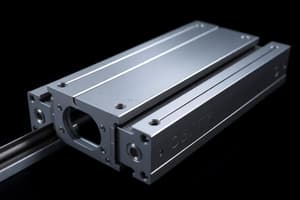Podcast
Questions and Answers
What is the main difference between static friction and kinetic friction?
What is the main difference between static friction and kinetic friction?
- Static friction occurs when surfaces are sliding, while kinetic friction occurs when surfaces are stationary.
- Static friction is the force maintaining contact between surfaces, while kinetic friction is the force preventing slippage.
- Static friction occurs when surfaces are stationary, while kinetic friction occurs when surfaces are sliding. (correct)
- Static friction is the force preventing slippage, while kinetic friction is the force maintaining contact between surfaces.
How does the coefficient of friction change with sliding speed?
How does the coefficient of friction change with sliding speed?
- It remains constant regardless of sliding speed.
- It increases as sliding speed increases.
- It fluctuates depending on the substance and sliding speed. (correct)
- It decreases as sliding speed increases.
What effect does wetness have on the friction characteristics of silicon dioxide (SiO₂)?
What effect does wetness have on the friction characteristics of silicon dioxide (SiO₂)?
- Dry conditions reduce the friction of SiO₂.
- Wet conditions reduce the friction of SiO₂.
- Dry conditions increase the friction of SiO₂. (correct)
- Wet conditions increase the friction of SiO₂.
How can one minimize sliding friction between surfaces?
How can one minimize sliding friction between surfaces?
Which type of friction lays a foundation for better comprehending the physical principle?
Which type of friction lays a foundation for better comprehending the physical principle?
What role does normal force play in calculating friction according to Amonton's law?
What role does normal force play in calculating friction according to Amonton's law?
How do lubricants reduce friction between surfaces?
How do lubricants reduce friction between surfaces?
What effect does high moisture content have on friction levels?
What effect does high moisture content have on friction levels?
How does temperature influence the friction characteristics of materials?
How does temperature influence the friction characteristics of materials?
Which microscopic mechanisms contribute to frictive behaviors at the nanoscale?
Which microscopic mechanisms contribute to frictive behaviors at the nanoscale?
Flashcards are hidden until you start studying
Study Notes
Understanding Sliding Friction
Friction plays a fundamental role in everyday life, influencing phenomena such as stopping cars and maintaining grip while walking. Sliding friction specifically concerns the resistance experienced when two surfaces move over each other horizontally, often referred to as kinetic friction. This type of friction contrasts with static friction, which applies when surfaces are stationary relative to each other.
Factors Affecting Sliding Friction
Several parameters influence sliding friction. These include:
- Surface Deformation: The ability of the contacting bodies to deform influences their interaction and consequently, the resulting friction.
- Surface Roughness: Smooth surfaces exhibit lower friction compared to rough ones due to fewer points of direct contact.
- Original Speed of Objects: Initially moving objects experience increased friction forces.
- Object Size: Generally, large objects generate stronger friction forces.
- Pressure on Objects: Increased pressure leads to enhanced friction.
Reducing Sliding Friction
Reduced friction is desirable in applications requiring smooth motion or minimal wear. Possible methods to achieve this goal include:
- Use Lubricants: Applying lubricating agents allows surfaces to glide past each other with reduced resistance.
- Match Material Properties: Selecting materials with similar properties minimizes differences in interactions between surfaces, thereby reducing friction.
- Enhance Surface Finishing Techniques: Improving the surface finish reduces microscopic protrusions, leading to smoother contacts.
Static versus Kinetic Friction
Static friction refers to the force preventing slippage between surfaces that are not currently sliding. When surfaces begin to move relative to one another, static friction gives way to kinetic friction. The coefficient of friction—which describes the proportional relation between friction force and normal force—varies depending on sliding speed.
As sliding speed increases, the coefficient of friction changes according to specific trends unique to the type of substance involved. For example, silicon dioxide (SiO₂) exhibits varying friction characteristics when wet and dry, with increasing friction levels observed under dry conditions as speed rises.
In summary, understanding the contributing factors behind sliding friction, knowing techniques to minimize it, and appreciating its distinction from static friction lays a foundation for better comprehending this ubiquitous physical principle.
Studying That Suits You
Use AI to generate personalized quizzes and flashcards to suit your learning preferences.




